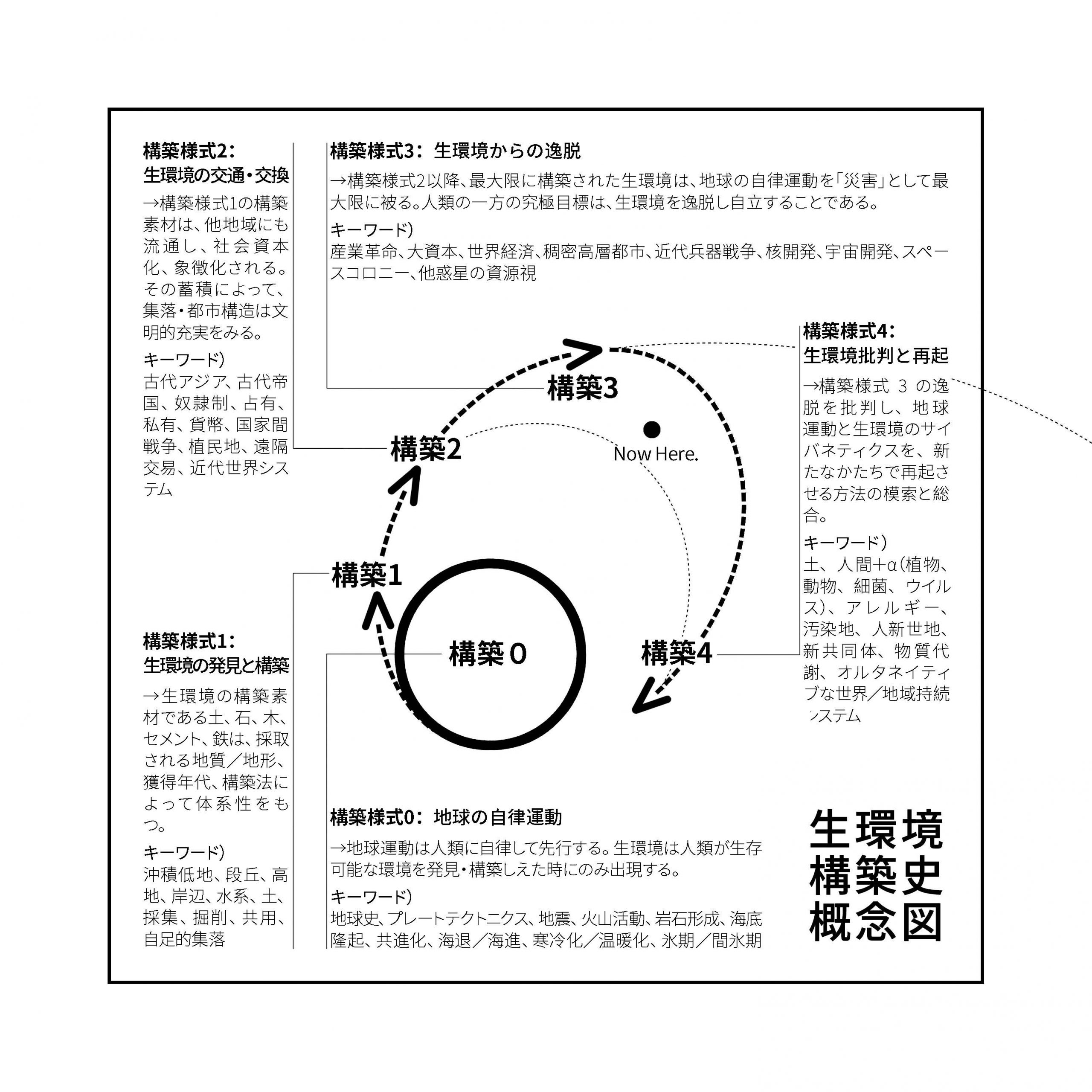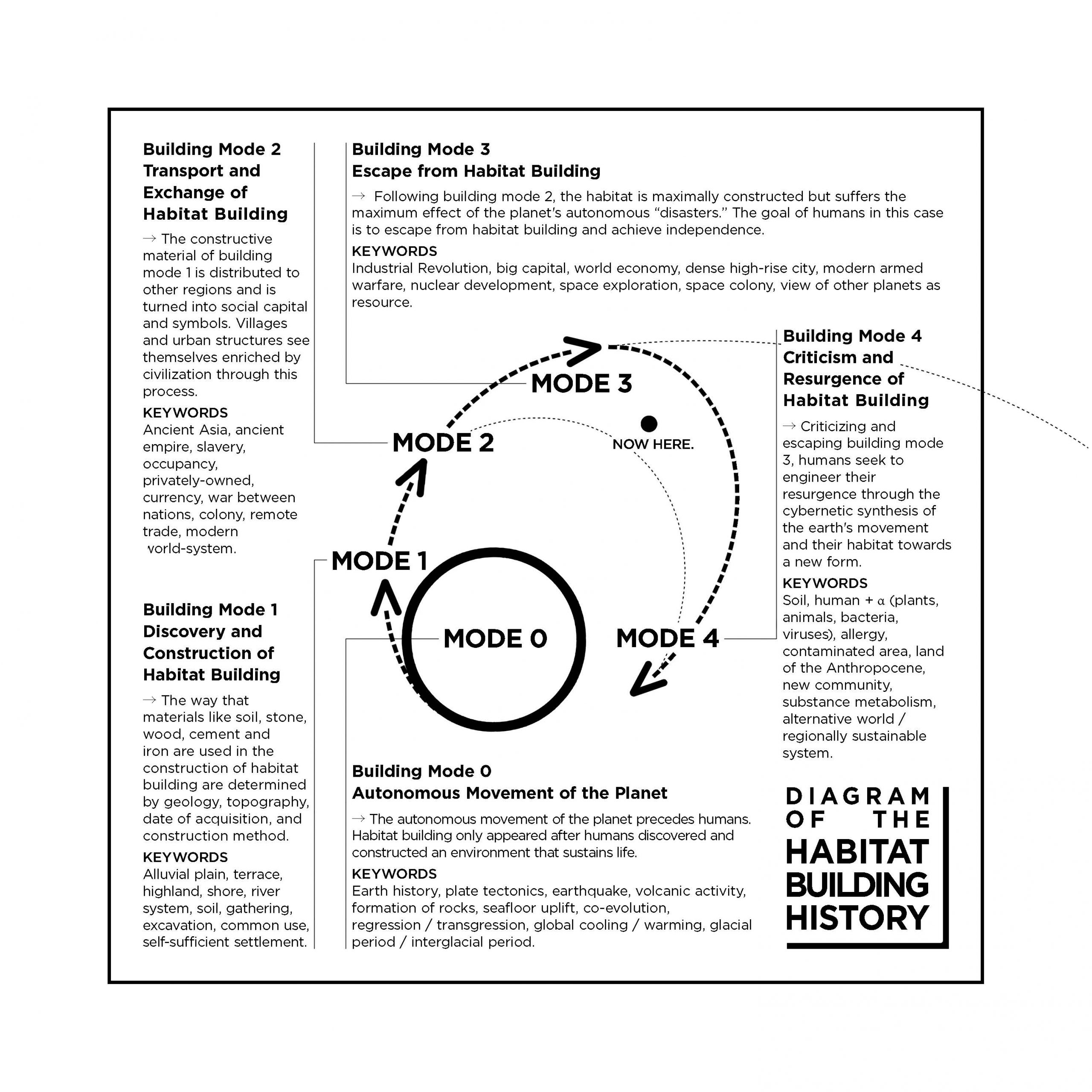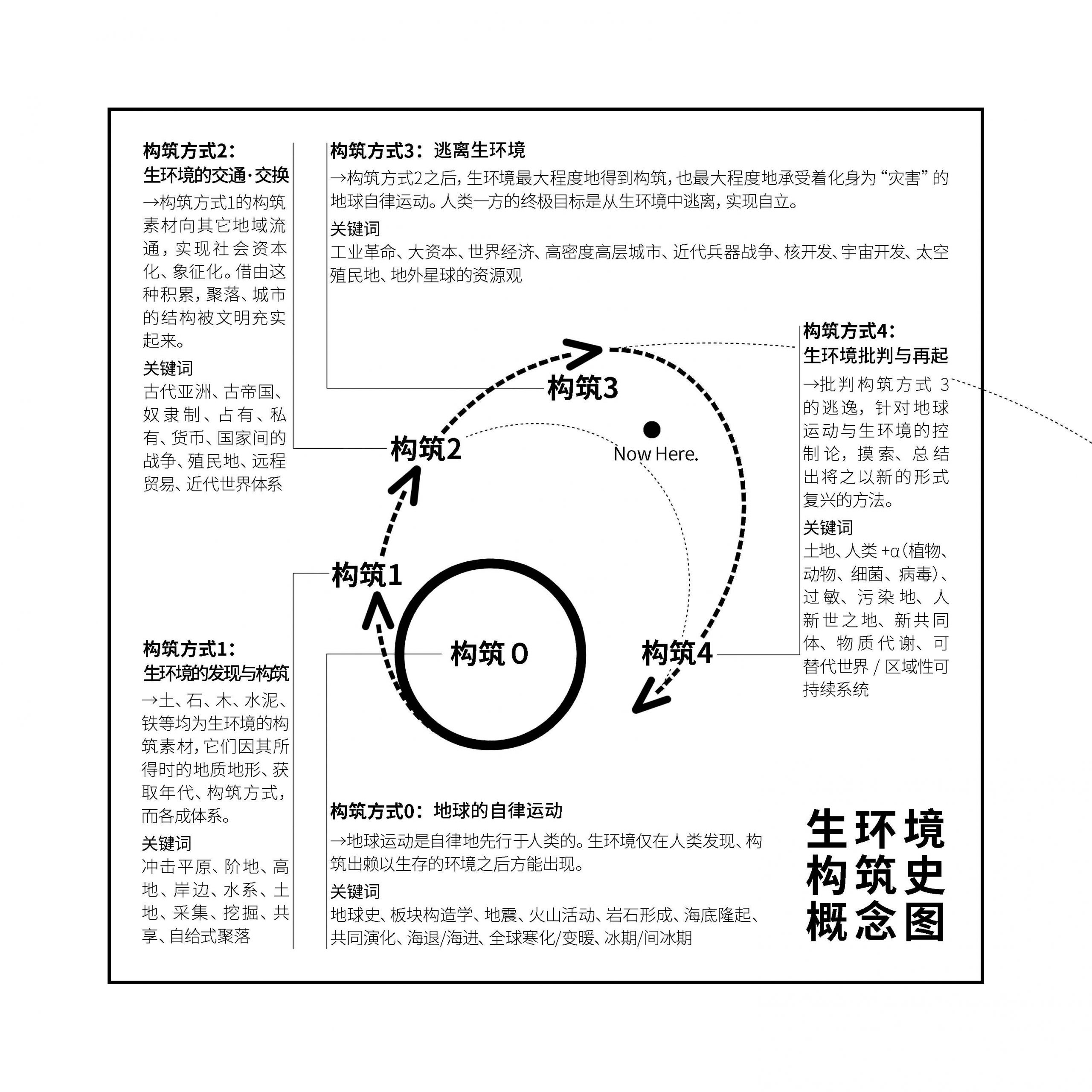第1号特集:SF生環境構築史大全
A Sci-Fi Guide to Habitat Building History
科幻生環境構築史大全



はじめに
このWebzineは生環境構築史の運動の一環として発行される。そのキックオフとして、私たちは、生環境構築史における未知の構築様式「4」の姿を、サイエンス・フィクションを援用して探索する特集を組んだ。
生環境構築史とは何か。それは、地球に生存する人類の歴史とその未来を、構築様式(=Building Mode)という新しい歴史観からとらえ直そうとする考え方である(詳しくは「生環境構築史宣言」を参照のこと)。
構築様式とは、文字通り人類が自ら生き続けることを目指して作り出してきた、地球上の構築活動の類型をさしている。いうまでもなく地球は、人類がのちに生まれることを前提に誕生したわけではないし、人類が存在しなくてもその活動は続く。つまり、地球の上では、人類は生存可能な環境を地球上で発見・構築・改変しえたときのみに生きることができたのだ。それは大きく以下の段階をもつ。
まずは構築様式0、地球それ自体である。
構築様式1から人間の活動が入り込む。構築様式0の合間から人類がその生存にとってより適切な環境を築くための素材を身近な自然物から発見し、それを身体の機能の拡張から始まったような技術を用いて改変していった段階である。
次に来るのが構築様式2。ここでは各地域間の闘争を含む素材と技術の交流を通して富が移動し蓄積され、とりわけ蓄積が進んだ地域でさらに高機能な技術が生み出され、いわゆる文明が発生した。
そして今、大きな課題となっているのが構築様式3である。それは産業革命以降にはっきりと現れた大地と文明との拮抗的な関係であるといってよい。人類文明はとうとう地球=構築0からの完全な自立を目指して超高層都市を建設し、宇宙にまで飛び立とうとしたのである。資本をエンジンとするその様式において地球は消尽される材料と燃料に成り果てつつある。それははたして望まれるべき未来だったのだろうか。
構築様式4は、それ以前の諸技術を起点としつつも、材料と燃料が無尽蔵であるという構築3の基本的な考え方を捨て、地球=構築0との動的平衡関係を再び取り結びうるような未知の様式である。
ではいったい、それはどのようなものなのだろうか。
サイエンス・フィクションですでに綿密にほどこされてきた未知の世界をめぐる諸検討は、構築様式4を、ユートピアめいた古典的な地球回帰や原理的運動から抜け出す回路をつくってくれるだろう。生環境構築史は、サイエンス・フィクションとの接続を果たす必要がどうしてもあったのだ。
(第1号特集担当:中谷礼仁、日埜直彦、藤原辰史)
Introduction
The inaugural issue of the Habitat Building History webzine is “A Sci-Fi Guide to Habitat Building History, ” a collection of essays exploring the shape of what we call “Building Mode 4” through the wisdom of science fiction. What is Habitat Building History? It is a historical approach that aims to reconceptualize the history and future of mankind by focusing on the various “building modes” that describe how humans construct their lives in relation to the activities of Earth (See more description for HBH concept on this page; Manifesto of HBH). Needless to say, Earth was active before humans appeared, and it will continue its activity with or without us. In other words, Earth does not adjust itself for humans to live; it could be said that we can only keep living on Earth within a sustainable environment that we can find, build, and transform.
HBH has five stages, Building Mode 0 to 4. Building Mode 0 refers to the Earth itself that humans discovered as a foundation for a built living environment. In Building Mode 1, the honing of the body and new forms of technology saw humans transforming the earth’s material resources to build a suitable environment. The next is Building Mode 2, where technology, culture and resources were diffused through invasions and wars, a process that led to civilizations to form in areas of material concentration. And now, we have Building Mode 3, in which humans have established an antagonistic relationship with the planet in the wake of the Industrial Revolution, prompting them to look beyond the surface of Earth towards skyscraper cities and even to the cosmos. The planet has become a finite and consumable resource based on the capitalist system we have created, but is this the future we hoped for?
With Mode 3 being a concern and rather unsolved, we are moving forward to the next stage, Building Mode 4. Although this stage has been materialized from the technology humans developed since Mode 1, we are leaving the idea of having finite resources on Earth behind, reconstructing a dynamic homeostasis that enables us to maintain a stable relation to Earth. Be that as it may, what would Building Mode 4 look like? The sci-fi worlds that have been envisioning the unexpected future for a long period of time would help us to create a new way from modern civilization and root out the old concept of having to be on Earth. Moreover, it would be necessary for HBH to land on the sci-fi worlds to undertake the shape of Building Mode 4. (Translation by Mimu Sakuma, Matthew Mullane)
(First Issue Editors: Nakatani Norihito, Hino Naohiko, Fujihara Tatsushi)
序
本网络杂志是“生环境构筑史”运动的一环。值此起首,我们以科幻作品为主题编写本集,旨在一窥生环境构筑史中“构筑方式4”的未知真容。
生环境构筑史是什么──是一种思考方式,一种试图从新的历史观“构筑方式(Building Mode)”出发,重新审视生存在地球上的人类之历史及未来的思考方式(详参「生環境構築史宣言」)。
构筑方式,顾名思义,即人类为自身生存而制造出的各种构筑活动的类型。自不必说,地球并不是以养育人类为前提诞生的。即便人类不存在,其自身活动也会一如既往地持续下去。换言之,人类只有在地球上发现足以容人存活的环境,或构筑、改造出这种环境的时候,才得以存续。大致分为以下阶段:
首先,构筑方式0即地球的自身活动。
从构筑方式1开始,人类的活动加入其中。在构筑方式0的间隙,人类从身边的自然之中发现更加有利于自身生存的环境构筑素材。通过使用这些素材弥补、延展人体机能,人类开始建构与其相关的低技术,因此发生了这一阶段的改变。
接下来是构筑方式2。在此阶段,借由素材、技术的交流(包括争斗在内),各地的财富逐渐移动、积累。积累更为充沛的地区诞生出了相对更高级的技术,就此产生了所谓的文明。
现如今,构筑方式3是我们面临的一大课题。此阶段体现出了大地与文明间的对抗关系──这种对抗是在工业革命后陡然出现的。人类的目标是脱离地球(构筑0),实现完全的自立,因而开始建设超高层城市,乃至飞向宇宙。此时,资本成为了引擎,地球则成为了一种终将被耗尽的材料和燃料。
构筑方式4将之前掌握的诸种技术作为出发点,同时舍弃构筑方式3的思考方式,并不认为材料与燃料是取之不竭的无尽宝藏。它尝试与地球(构筑方式0)缔结动态的平衡关系,是一种未知的构筑方式。
那么,它究竟是怎样的呢──
科幻作品已然细致地畅想了那个未知的世界。在诸多的科幻讨论之中,构筑方式4未必遵循经典的回归地球的乌托邦式情节,亦不盲从于原理性的运动,反而试图挣脱、创造出崭新的路线。因此,生环境构筑史绝对有必要与科幻作品建立联系。
(第一号主编 中谷礼仁,日埜直彦,藤原辰史)
[2020.11.1 UPDATE]



